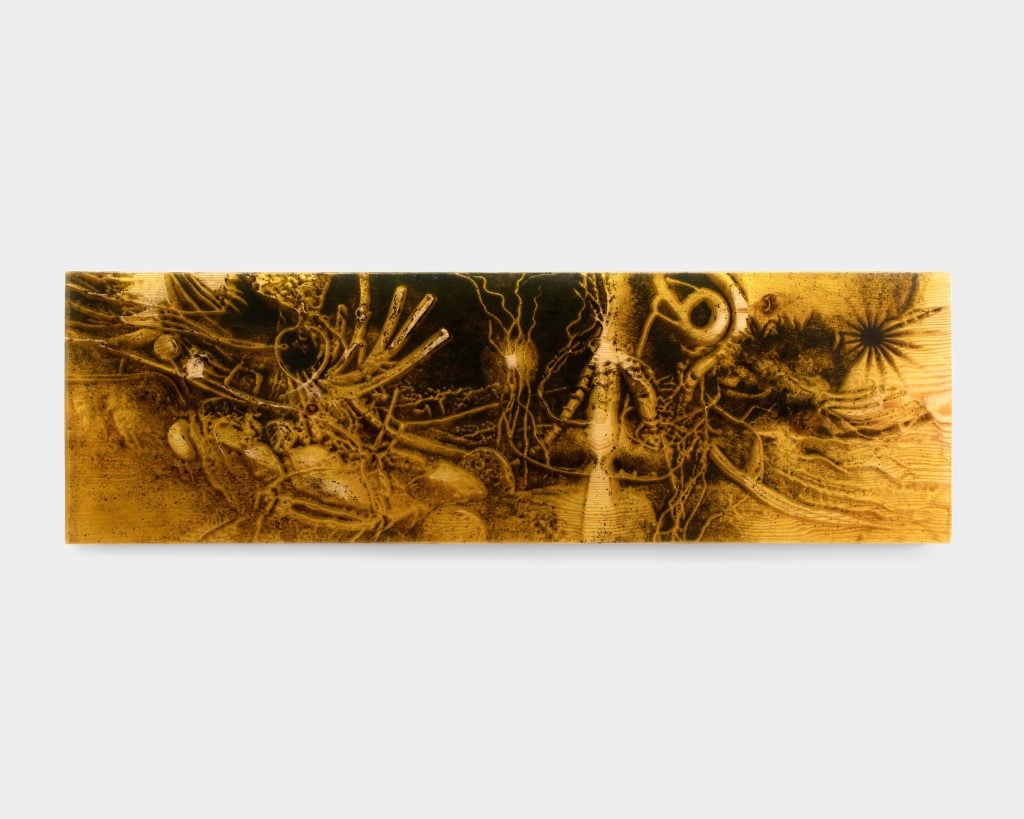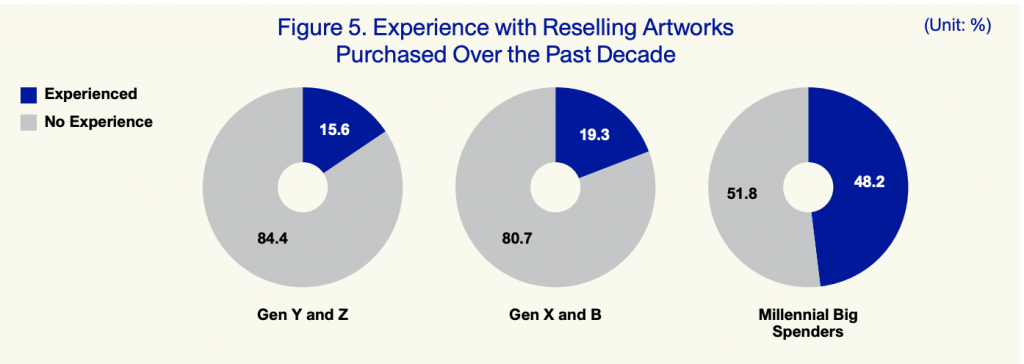The Back Room
The Back Room: Rise of the Machines
This week: A.I. chatbots approach the art world, Korea’s changing market, the Met’s sneaky Philip Guston drama, and much more.

This week: A.I. chatbots approach the art world, Korea’s changing market, the Met’s sneaky Philip Guston drama, and much more.

Artnet News

Every Friday, Artnet News Pro members get exclusive access to the Back Room, our lively recap funneling only the week’s must-know intel into a nimble read you’ll actually enjoy.
This week in the Back Room: A.I. chatbots approach the art world, Korea’s changing market, the Met’s sneaky Philip Guston drama, and much more—all in a 6-minute read (1,583 words).
__________________________________________________________________________

Jura Shust, Walking, knocking on the roots, and shaking the spruce paws #7 (2023). Photo by installshots.art. Courtesy of Management.
Developments in artificial intelligence keep grabbing headlines in 2023, and the latest model getting airtime is an A.I.-powered chatbot that is already upending industries ranging from education, to journalism, to coding. Now, the art industry is due for a reckoning, too.
Called ChatGPT, the software qualifies as a so-called Large Language Model (LLM)—basically, an algorithm trained on a gargantuan amount of text-based information scraped from the internet.
Over time, and through extreme repetition, LLMs learn how to generate new texts of varying size from short-form written prompts, with the results usually sounding convincingly informed and human.
In this week’s Gray Market, Tim sketched out ChatGPT’s likely appeal to, and limits in, the art industry. In his words: “Images may be central to this industry, but text is the main tool wielded to give all those images meaning, context, and marketing support.”
On one hand, the latest generation of A.I.-powered chatbots mean that it is suddenly faster and cheaper to automate certain kinds of art-world texts than it would be to hire a human to write them.
Potential use cases include…
However, before everyone runs off to fire their interns and junior cataloguers, it’s critical to understand where ChatGPT and its ilk still fall short—and why grappling with artwork might be what Tim calls “the ultimate stress test for this technology.”
Since A.I. chatbots learn from vast amounts of data that already exist in the world, they are best at generating texts about individual artists or movements that have been written about a lot, and emerging or overlooked artists whose practices fit neatly into styles or categories that have been written about a lot.
For example, think of well-trodden subjects like Picasso or Abstract Expressionism—or even artist statements about young painters making figuration centered on personal identity.
The flipside is that the technology breaks down whenever it’s prompted to consider artists or artworks that are doing something genuinely new or unconventional. So far, the machines literally do not have the frame of reference to assess these subjects.
One case study is artist Jura Shust, whose current solo show at Management gallery in New York exploits the gaps in an A.I.’s comprehension of folklore lacking a written record. With few online reference points to draw from, the algorithm essentially has to guess what it should produce based on Shust’s niche inputs. The artistic results are rich because the functional results are poor.
So, ChatGPT cannot penetrate the heights of artistic or literary achievement. But it’s also worth remembering that, as Tim wrote, “the majority of art made in the world, and the majority of text churned out about it, is relatively generic”—and therefore fair game for A.I.-powered chatbots.
__________________________________________________________________________
As art businesses seek to cut costs and find efficiencies in 2023, ChatGPT will almost undoubtedly come into play. Too many people want quick, cheap, just-good-enough wall texts, press releases, or online-only essays about the canonical and the typical. This is the audience for automation.
But the technology hasn’t yet grown sophisticated enough to replace humans able to whip up genuinely revelatory texts (or to supply the social allure of a big-name writer). If and when it levels up enough to negate this critique, we’ll have bigger concerns than the effects on the art world.
The latest Wet Paint tracks the next generation of young collectors flocking to the antiques and decorative art at the Winter Show, then gets the low-down on a fake George Condo sold on a sketchy auction website.
Here’s what else made a mark around the industry since last Friday morning…
Art Fairs
At this year’s FOG Design and Art Fair in San Francisco, “dealers [reported] strong sales and [marveled] in the evening’s upbeat energy.” (Artnet News)
TEFAF named the 78 exhibitors on tap for its New York expo (May 12–16 at the Park Avenue Armory). Joining mainstays Axel Vervoordt, Ben Brown Fine Arts, and Gagosian are 12 first-timers, including LGDR, Karma, and Templon. (Press release)
Auction Houses
Christie’s series of Old Masters sales in New York this week brought in a net total of $62.7 million, south of their aggregate low estimates. The top seller was a Francisco Goya painting that went for a premium-inclusive $16.4 million, a new auction high for the artist. (The Art Newspaper)
Galleries
Simon Dickinson’s son, Milo Dickinson, is joining his father’s eponymous gallery as managing director after 12 years as Christie’s head of private sales for Old Masters. (Financial Times)
Robert Grosvenor left Paula Cooper after more than five decades, though an exhibition of his work is on view now at the gallery’s West 21st Street space through January 28. He maintains representation with Galerie Max Hetzler and Karma. (ARTnews)
Institutions
After 15 years as director of the Reina Sofia, Manuel Borja-Villel chose not to seek re-election when his latest term ended on January 20. Deputy artistic director Mabel Tapia will take charge of the museum until a new election can be held. (El Pais)
In May, Kathy Halbreich will step down as executive director of the Robert Rauschenberg Foundation, where she has served since 2017. The board is now seeking her replacement. (Press release)
Tech and Law
Susannah Maybank, the former head of digital at Gagosian, and Mariam Naficy, the founder of design marketplace Minted, have joined forces to create Tonic, a new NFT marketplace. (Artnet News)
____________________________________________________________________________
“Accepting so many free Guston paintings flies in the face of the challenge that many museums face right now to redefine their missions in the wake of the Black Lives Matter movement. Practically, and symbolically, it takes up too much of the oxygen in the room.”
—Critic Roberta Smith, on the Met‘s decision to accept a gift of 220 works by Philip Guston (plus $10 million) from his daughter, Musa Guston Mayer. The museum will now hold dozens more pieces by Guston than by any other European or American painter, living or dead, reinforcing what Smith calls the “so-called master narrative that has largely excluded the achievements of women and artists of color” even as institutions should be doing the opposite. (New York Times)

Chart courtesy of Seoul National University, Paradise Cultural Foundation, and the Korea Arts Management Service.
The trade volume of South Korea’s art market in 2022 surpassed ₩1 trillion ($812 million) for the first time ever, according to a new English-language report led by Seoul National University. For better and for worse, a major force in the changing shape of the nation’s art industry is the top 20 percent of millennial and zoomer collectors—a subgroup the authors label the “Big Spenders”…
Overall, the report does an admirable job of balancing the positives and the perils of Korea’s burgeoning art trade. Click through below for more data-led takeaways about the nation’s ambitions to cement itself as a global market player.
—Vivienne Chow
____________________________________________________________________________